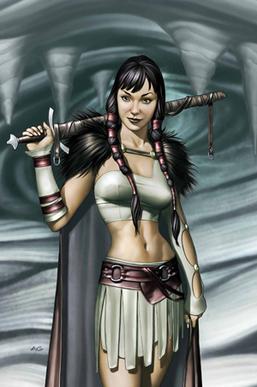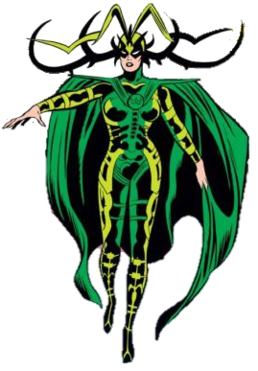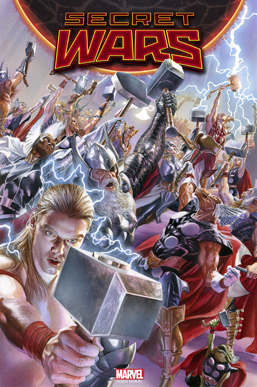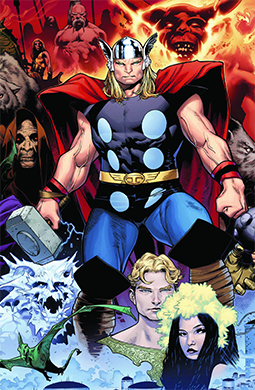
Odin Borson, the All-Father is a fictional character appearing in American comic books published by Marvel Comics. First mentioned in Journey into Mystery #85, the character first appears in Journey into Mystery #86, and was adapted from the Odin of Norse mythology by Stan Lee and Jack Kirby. The character is depicted as the father of Thor and, traditionally, as the king of Asgard.

Beta Ray Bill is a fictional superhero appearing in American comic books published by Marvel Comics. Debuting in the Bronze Age of Comic Books, the character was initially intended to be a surprise; an apparent monster who unexpectedly turns out to be a great hero. As such, Bill is the first being outside the Marvel Universe's Norse pantheon to be introduced as being worthy to wield Thor's hammer, Mjolnir. After an initial rivalry with Thor for possession of the weapon, the alien warrior was granted a war hammer of his own, called Stormbreaker, and the two reconciled as staunch allies, going on to fight side by side.

Loki Laufeyson is a character appearing in American comic books published by Marvel Comics. Created by writer Stan Lee, scripter Larry Lieber, and penciller Jack Kirby, he is based on the Norse mythological deity of the same name. Although a version of Loki debuted in Venus #6, his characterization as the adoptive brother and nemesis of the superhero Thor was introduced with the version that debuted in Journey into Mystery #85, which has persisted to the modern age.

In the Ultimate Marvel universe, Thorlief "Thor" Golmen is a fictional superhero based on the Marvel Universe version of Thor, who is the Asgardian God of Thunder and a founding member of the Ultimates. Also known as "Ultimate Thor", Golmen is an anarchist who discovers he is the reincarnated form of the Norse warrior god Thor. The "Ultimate" redesign of the character reduces the number of Thor's powers, and reduces the character's reliance upon his hammer. Perhaps most significantly, the Thunder God's long-established personality is drastically altered, changing him from an eager and willing divine combatant into an ecocentric, arguably unstable, and reluctant warrior.

Mjolnir, known more formally as Mjölnir, is a fictional magical weapon appearing in American comic books published by Marvel Comics. It is depicted as the principal weapon of the superhero Thor. Mjolnir, which first appears in Journey into Mystery #83, was created by writers Stan Lee and Larry Lieber and designed by artists Jack Kirby and Joe Sinnott.

Heimdall is a fictional character appearing in American comic books published by Marvel Comics. The character is based on the Norse deity Heimdall. Heimdall is described as all-seeing and all-hearing and is the sole protector of the Bifröst in Asgard.

Sif is a character appearing in American comic books published by Marvel Comics. Created by Stan Lee and Jack Kirby, the character first appeared in Journey into Mystery #102. She is based on the Norse goddess Sif. As an Asgardian warrior and lover of Thor, Sif often accompanies him into battle. She has also battled alongside Balder, who has developed an unrequited attraction to her, as she never shows affection for anyone but Thor and certain individuals who have proved worthy to wield his hammer, Mjolnir, such as the noble alien warrior Beta Ray Bill, and the mortal Eric Masterson.

Mangog is a character appearing in American comic books published by Marvel Comics.

Jane Foster is a superhero appearing in American comic books published by Marvel Comics. Created by writers Stan Lee, Larry Lieber, and artist Jack Kirby, the character first appeared in Journey into Mystery #84. Jane Foster was introduced as a love interest of the superhero Thor Odinson until becoming a superhero in her own right.

Hela is a fictional character appearing in American comic books published by Marvel Comics. She is based on the goddess Hel from Norse mythology, and was first adapted by Stan Lee and Jack Kirby in Journey into Mystery #102. Hela is the Asgardian Goddess of Death who serves as the ruler of Hel and Niflheim. The character is usually depicted as an adversary of the superhero Thor.

Thor was created by Stan Lee, Larry Lieber and Jack Kirby. There had been multiple alternative versions of Thor, both in the main continuity as well as alternate stories. The character is based on the Norse deity Thor.

Thor Odinson is a superhero appearing in American comic books published by Marvel Comics, based on the god from Old Norse religion and mythology, Thor (Þórr). Created by artist Jack Kirby, writer Stan Lee, and scripter Larry Lieber, the character first appeared in Journey into Mystery #83 (1962) and first received his own title with Thor #126 (1966). Thor is an adaptation of the deity of the same name from Norse mythology, and many aspects of Thor's character are based on his mythological counterpart. Comic books featuring Thor have been published across several volumes since the character's introduction.
The Infinity Stones are fictional items in the Marvel Cinematic Universe (MCU) media franchise, based on the Infinity Gems of the Marvel Comics. As expounded across several interwoven MCU multimedia titles, the six Infinity Stones are reputed to embody and control essential aspects of existence—Space, Mind, Reality, Power, Time, and Soul—thereby making them critical artifacts in the MCU and, together, the MacGuffin of the dedicated Infinity Saga.
There are different types of fictional dwarves appearing in American comic books published by Marvel Comics. The most common of the Dwarves are the ones that are based on the dwarves of Norse mythology. They frequently appear in stories featuring the superhero Thor.

Thor Odinson is a fictional character portrayed by Chris Hemsworth in the Marvel Cinematic Universe (MCU) media franchise, based on the Marvel Comics character of the same name and the Norse mythological god of thunder. In the MCU, he is depicted as one of the most powerful Asgardians, an ancient alien civilization with long ties to Earth, who humans consider to be gods. Thor wields a powerful hammer called Mjolnir, and is initially depicted as the arrogant heir to the throne of Asgard whose brash behaviors causes turmoil among the Nine Realms under Asgard's protection. This brings him into conflict with his villainous adopted brother, Loki, the god of mischief.
Eitri is a fictional character appearing in American comic books published by Marvel Comics. Eitri is a Dwarf who lives on Svartalfheim and is the King of the Dwarves. He is a weapons forger and is notable for being the creator of Thor's hammer Mjolnir. Eitri has also occasionally aided the New Mutants.

Gorr the God Butcher is a supervillain appearing in American comic books published by Marvel Comics. Created by Jason Aaron and Esad Ribic, Gorr first appeared in Thor: God of Thunder #2.
The Marvel Cinematic Universe (MCU) media franchise features many fictional elements, including locations, weapons, and artifacts. Many are based on elements that originally appeared in the American comic books published by Marvel Comics, while others were created for the MCU.

Jane Foster is a fictional character in the film and television franchise Marvel Cinematic Universe (MCU) portrayed by Natalie Portman, based on the character of the same name from Marvel Comics created by Stan Lee, Larry Lieber, and Jack Kirby.
















